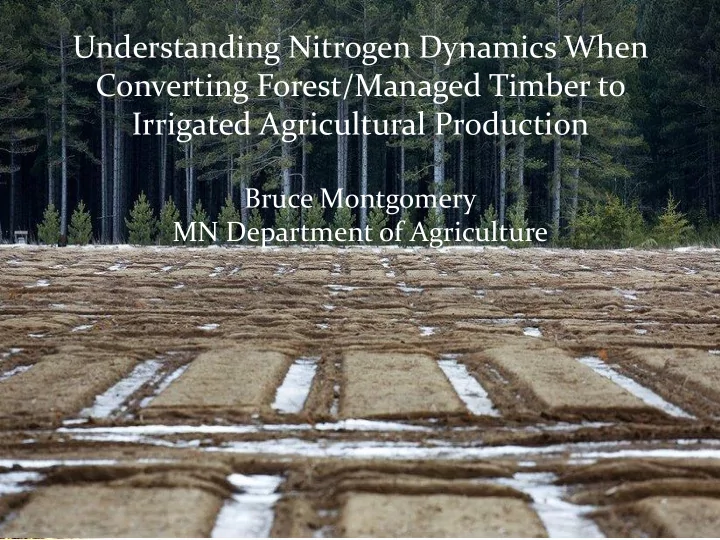

Understanding Nitrogen Dynamics When Converting Forest/Managed Timber to Irrigated Agricultural Production Bruce Montgomery MN Department of Agriculture
Past Work Experience………assessing the environmental impacts of the Garrison Diversion Irrigation Project in North Dakota Oakes Irrigation Test Area
Key Environmental Issues---Garrison Diversion Could we manage nitrogen losses adequately to protect Hudson Bay with this massive irrigation expansion? Biota transfer from the Missouri River into Hudson Bay was another significant concern.
Understanding Nitrogen Behavior Is Critical
Drastic Land Use Changes Such as Plowing Virgin Prairie or Woodlands Will Have Temporal Impacts on the Release of Organic Nitrogen These Changes Are Rarely Documented
NDSU Research Large Undisturbed Soil Columns Were Used at the N.D. Research Sites to Monitor Nitrogen Movement
NDSU Research “Nitrogen Flush” from the Conversion of Dryland to Irrigated Conditions Took Two to Five Years to Equilibrate 180 Phase 1 Phase 2 Phase 3 160 Observed concentrations Undisturbed Equation [1] fit 140 10 mg L -1 MCL Soil Columns Nitrate-N (mg L-1) 120 Calculated from soil test N 100 80 60 40 NDSU Research 20 0 Jan-89 Jan-90 Jan-91 Jan-92 Jan-93 Jan-94 Jan-95 Jan-96 Jan-97 Jan-98 Jan-99 Jan-00 Jan-01 80 Phase 1 Phase 2 Phase 3 Intermediate Observed data 60 Monitoring -1 ) Equation [1] fit Nitrate-N (mg L 10 mg L -1 MCL 95 % Confidence Wells Interval 40 20 0 Jan-89 Jan-90 Jan-91 Jan-92 Jan-93 Jan-94 Jan-95 Jan-96 Jan-97 Jan-98 Jan-99 Jan-00 Jan-01
NDSU Research Understanding the accelerated mineralization rates from the Garrison Diversion Project provided the opportunity to: • Significantly reduce nitrogen fertilizer rates for the first 2-3 years after the conversion; • Separate water quality impacts from the organic N pool vs from the addition of nitrogen fertilizer
Implications Of Land Conversion within the Pineland Sands Area?
A Few Quick Stats Regarding the Potlatch/RDO Land Conversion Issue • Potlatch has sold 60,000 acres of timber/pine plantation holdings in MN but only 6,000- 8,000 suitable for irrigation; • The RDO Corporation originally planned to convert about 7,800 acres for agricultural use; • Potlatch: Taxes are 2-3 X as high in Minnesota than the southern states and northern trees take 50-70 years to mature while southern trees take 25-30. Ag Week Pates 6-2015
Byron Township Demonstration Site Cass County, MN Anticipating many environmental questions from the public, the foundation for a very unique partnership and water quality demonstration site began in 2013
Byron Township Demonstration Site Cass County, MN
Byron Site is Equipped to Monitor Nutrient and Percolation Losses Beyond the Root Zone
Typical Long-Term Installation Field Design Used by the MN Department of Agriculture >24” deep Installation Notes: • All piping placed below the depth of tillage operations • Lysimeters pull water from a depth of 4-6 feet deep • Below the crop root zone
Demonstration Goals at the Byron Site Starting with “NEAR PRISTINE” CONDITIONS……… Quantify the magnitude of temporal N flushes from the conversion of “managed timber” to irrigated production; Quantify nitrate leaching losses over multiple rotations which would include seed potatoes once every 3 rd or 4 th year; Minimize inputs and potentially reducing N losses by integrating “low input” crops within the rotation; Use cover cropping systems to the fullest extent possible to control off-season losses AND to minimize the use of soil fumigants such as Vapam.
Some Evidence of a Temporal Nitrate Flush During the First Production Year But Dissipated Relatively Quickly (Crop: Soybeans No Commercial Nitrogen Applied) 30.00 Average Nitrate-N Below the Root Zone 25.00 20.00 15.00 10.00 5.00 0.00
Nitrogen Losses Will Occur Even When BMPs and Water Management Are Implemented
Conceptual Relationship under Corn Production: Inputs, Yields and Environmental Outputs 1993-97 Simulation Year 200 70 180 60 160 Nitrate-N Loss 50 140 Yields (Bu/A) 120 40 100 Excess Inputs 30 80 Add’l Losses at Rec. Rate 60 20 40 “Background” Losses 10 Under Row Crop Systems 20 0 0 1 2 3 4 5 6 7 Nitrogen Rates (Lb/A)
Typical Irrigated Crop Rotation with Late Season Potatoes---Pineland Sands Region Russet Potatoes Corn Edible Beans
Proposed Alternative Rotation at Byron Potential N Inputs Reduced: 70-80% Potential Irrigation Use Reduced: 30-40% Soybeans Dark Red Kidney Beans Peas Seed Potatoes
Cover Crops Following Short Season Crops Will Serve an Important Role in Reducing Fall Soil Nitrate Levels
Rye and oats have been used as a successfully as a cover crop following a short-season crop such as small grains, peas or early season potatoes in Central Minnesota. Brown mustard, show here, produces ITCs (isothiocyanate compounds) which have a biocidal effect similar to Vapam.
Additional Rotations Proposed in Phase 2 of the Special Study (State Agencies) Late Season Potatoes Rotated with Low Impact Crops Traditional Irrigated Rotation Crops---No Potatoes Late Season Potatoes with Conventional Rotation Existing Byron Site-Low Impact Crops with Seed Potatoes
Today’s “Take Home” Message • The unique partnership and associated demonstration site is well positioned to answer some probing nitrogen related questions about timberland conversion and the long- term substantiality of a “highly input reduced” rotation; • Outcomes will help refine agricultural practices across Minnesota’s irrigated acres; • Additional sites are highly recommended to accurately reflect agricultural practices and rotations currently practiced across the Pineland Sands;
Recommend
More recommend